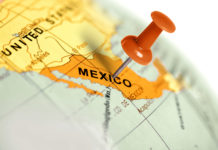Mexican Are Now the Fastest Americans!
Mexicans are overweight or obese – a problem that is reaching epidemic proportions. According to a recent report by the United Nations Food and Agricultural Organization (FAO), about 70 percent of Mexican adults are overweight, 32.8 percent of them are obese. This is more than the U.S.A.’s adult obesity rate of 31.8 percent, more than Canada’s rate of 22.3 percent, and more than any other country’s in the Americas.
Childhood obesity in Mexico has tripled in a decade and about a third of teenagers are fat as well. Experts say that one out of every five of those heavy kids will remain so their entire lives.
Weight-related diabetes claims the most Mexican lives each year, with nearly one of every six Mexican adults suffering from the disease. Diabetes alone kills as many as 70,000 people a year in Mexico – roughly equal to the deaths authorities say are caused by more than six years of the country’s gangland wars. More than 400,000 new cases are being diagnosed every year. Heart and related ailments round out the list of the country’s top killers.
The FAO blames increasingly industrialized agricultural production for a worldwide epidemic of both obesity and malnutrition. In Mexico, obesity is affected by this and a combination of factors including traditional foods, rising incomes and urban lifestyle, and the influx of American-style processed foods.
Traditional Mexican Food Underlies Much of the Problem
Traditional Mexican food referred to as “Vitamin T” – Tacos, Tamales, and Tostadas- underlies much of the country’s obesity problem. In past generations, when most Mexican lived on the land with hard physical labor, they worked off the high calories of these traditional foods. But now, with the more sedentary lifestyles of modern Mexico, these carbohydrate and lard-loaded dishes are resulting in bigger and bigger waistlines.
Salt is another problem in the Mexican diet. Mexicans use salt and chili on fruit and even candy. Mexicans love salt, so much so that some estimates show them eating nearly three times the recommended amount. Some areas are launching “anti-salt” campaigns to encourage restaurants to take salt shakers off their tables, providing shakers only if guests ask for them.
Junk Food is More Available
Many in Mexico blame the obesity problem on the growing popularity of U.S. fast food restaurants, junk food snacks, and processed food high in saturated fats, sugar and additives, which have spread rapidly since the opening of the local economy to global marketers in the early 1990s.
Urban Mexicans love pizzas, hamburgers and deep-fried chicken. Relatively cheap chips, cookies, and sugary soft drinks pack the shelves of the convenience stores and mom-and-pop groceries that are common even in poor rural towns and villages.
There are plenty of healthier food choices for Mexicans to eat like broth-based soups, fresh fish, salads, vegetables and tropical fruits. To achieve a more health-conscious menu, Mexican chefs now create plates that contain proteins and have low grease content with lots of vegetables.
More health-conscious plates use many of the classic Mexican ingredients like corn, mushrooms, cabbage, beans, squash and chilies along with a mix of aromatic herbs. Smaller portions are also encouraged. Many supermarkets are now offering fresher and lighter calorie food. Restaurants serving sushi, salads and the like are popular. Gyms and health clubs are sprouting up across the cities.
But high-quality, low-calorie foods tend to be more expensive for the Mexican poor and working class, especially those with larger families, and food costs have risen in recent times.
“For many Mexicans, particularly in urban areas or in the northern states, switching to healthier diets is becoming increasingly difficult,” UN expert Olivier de Shutter says in a report on Mexican agriculture and nutrition. In rural areas, cash for families from government anti-poverty programs is often spent on fried snacks and sodas rather than nutritious foods. The UN expert called for sweeping reforms that would refocus food production and consumption on more nutritious food available to more people.
Strategies to Fight Against Obesity
Mexico’s National Public Institute of Health recommends 10 strategies to fight against child and adult obesity:
- Promote and protect exclusive breastfeeding until 6 months of age, and then promote appropriate complementary feeding.
- Promote a balanced diet with increased consumption of fruits and vegetables, legumes, whole grains, and fiber.
- Increase the availability, accessibility, and consumption of drinking plain water.
- Regular physical activity in school environments, labor, community and recreational. At least 150 minutes a week of moderate-intensity physical activity is recommended for adults and 300 minutes for those under 18 years.
- Having more regulation on advertising on foods that are directed to children.
- Provide more nutritional options in settings such as schools.
- Educate parents about the value of food and avoid excesses – promote “health and nutrition literacy”.
- Avoid drinking alcohol.
- No smoking.
- Keep a positive attitude and personal development goals that encourage healthy behaviors and attitudes follow.
Sources:
Adult obesity rates in Canada reaching historic highs, UBC study warns | Toronto Star
10 estrategias de vida o muerte contra la obesidad – Articulo7
Related Articles:
Healthier Eating: New Trends in Mexican Cuisine | imagine-mexico.com











